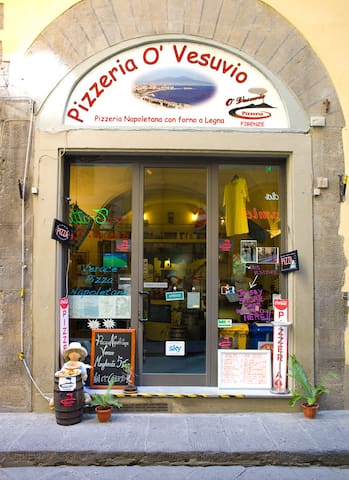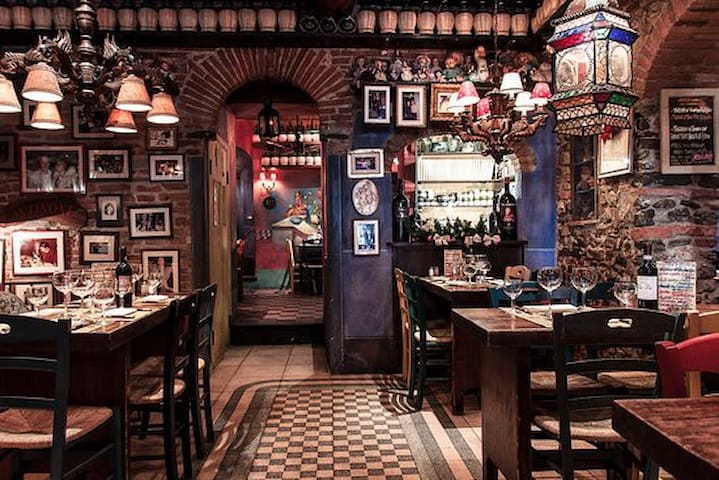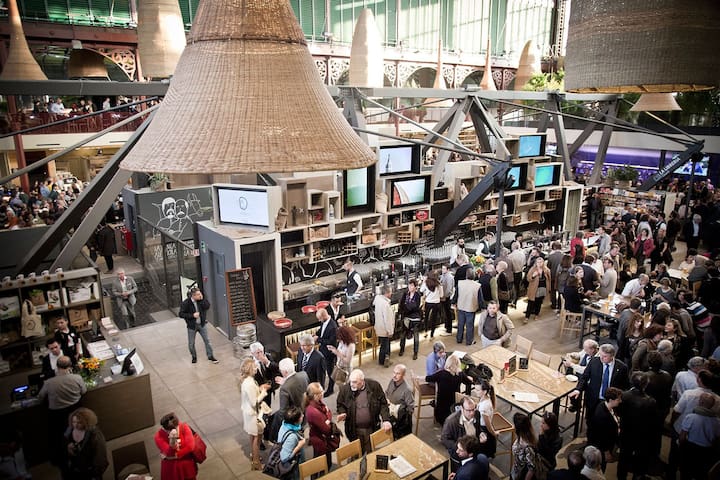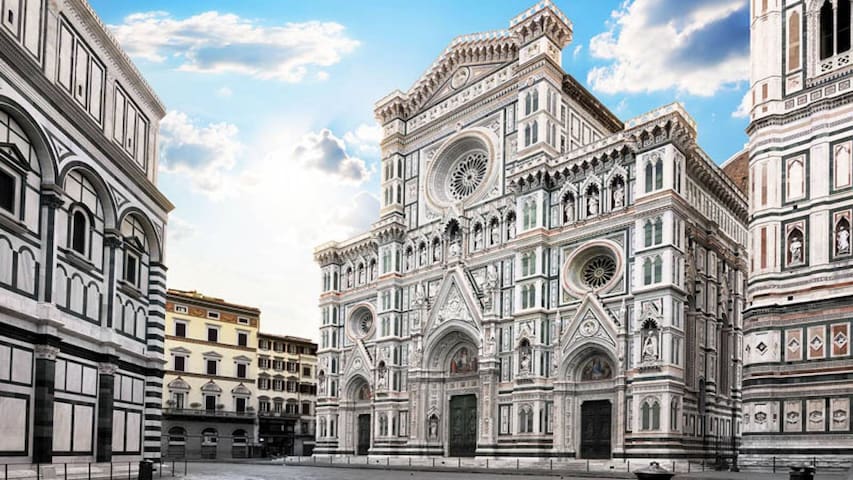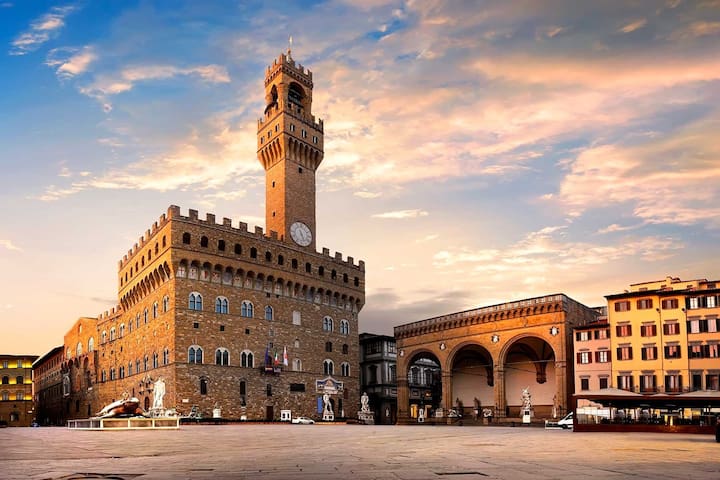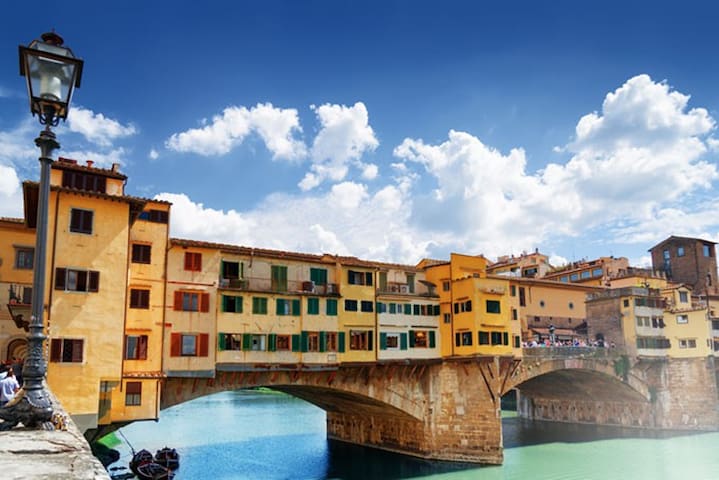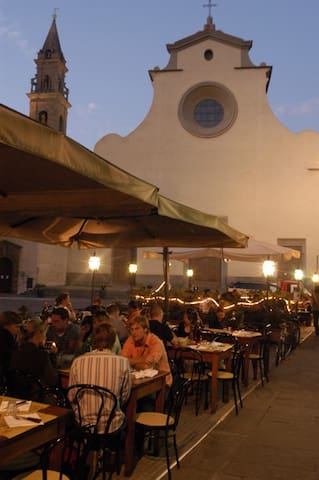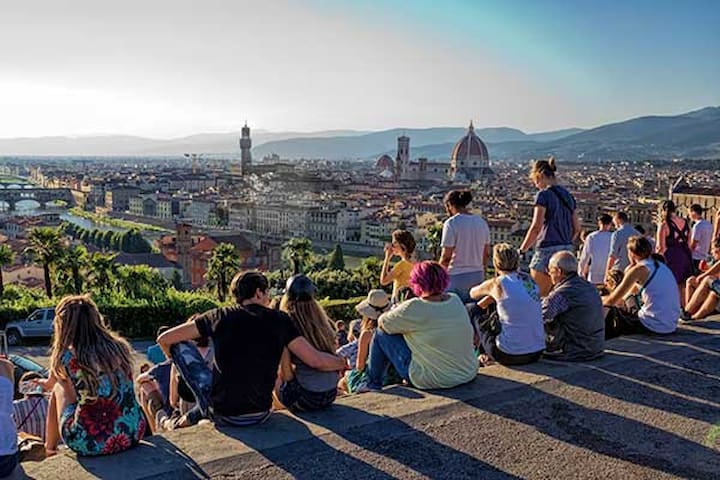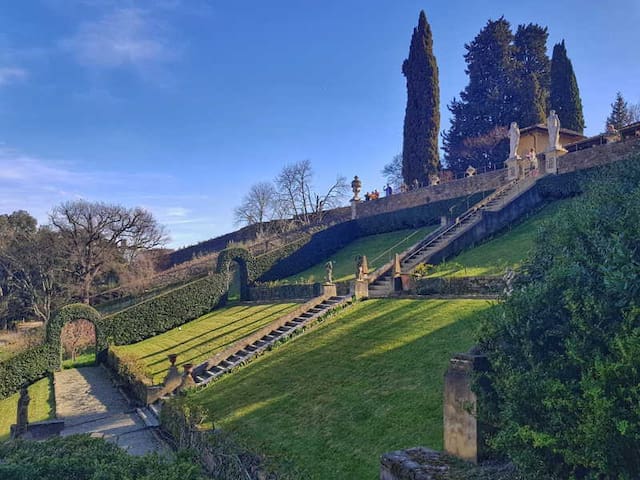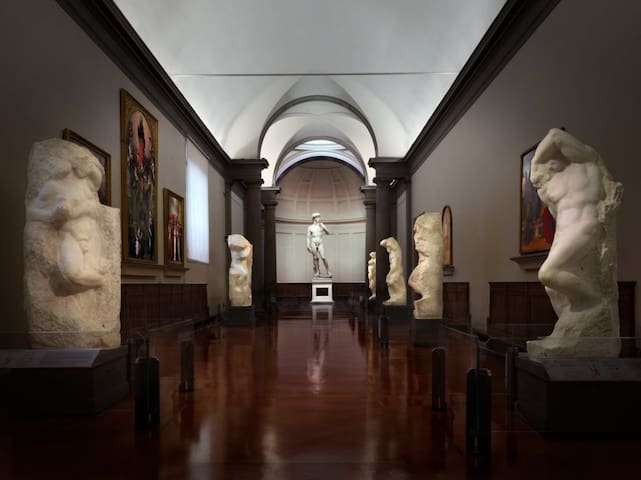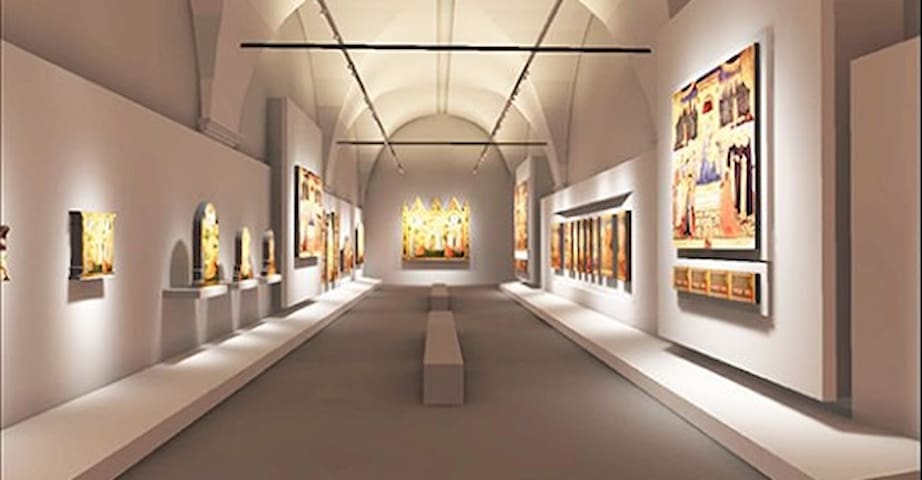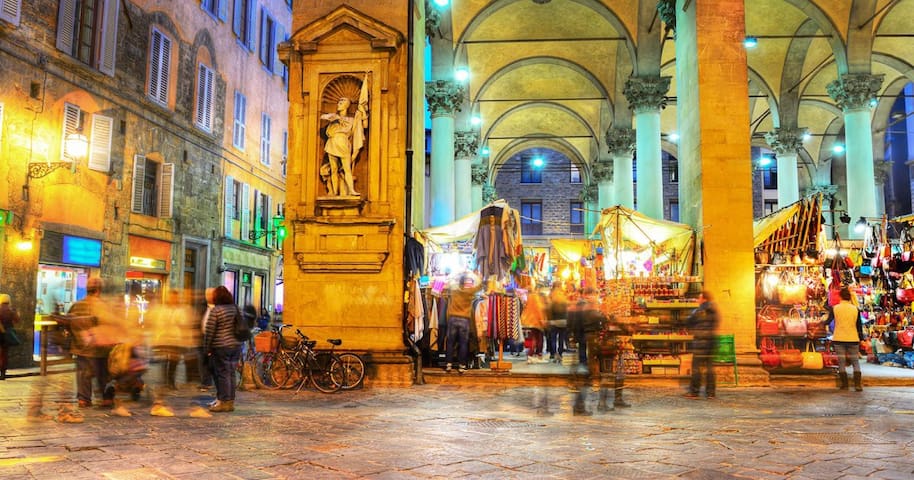Food Scene Brunch
Classic Neapolitan pizzas baked in a wood-fired oven and served in an essential dining room with an open kitchen.
16 当地人推荐
Pizzeria O'Vesuvio
21r Via dei CimatoriClassic Neapolitan pizzas baked in a wood-fired oven and served in an essential dining room with an open kitchen.
For a quick lunch you can get a "Porchetta" sandwich.
The "Porchetta" is a savory, fatty, and moist boneless pork roast of Italian culinary tradition.
Antica Porchetteria Granieri 1916 (Actual)
27/29 rosso Via Porta RossaFor a quick lunch you can get a "Porchetta" sandwich.
The "Porchetta" is a savory, fatty, and moist boneless pork roast of Italian culinary tradition.
Tuscan cuisine, and Florentine in particular, in this renowned trattoria, with a characteristic setting that overlooks the central market square; the menu is varied and the offer is varied
205 当地人推荐
Trattoria Zà Zà
26r Piazza del Mercato CentraleTuscan cuisine, and Florentine in particular, in this renowned trattoria, with a characteristic setting that overlooks the central market square; the menu is varied and the offer is varied
The perfect brunch in Florence spot to enjoy quality time with friends and even greater quality food.
Rooster Cafe Firenze - Porta Rossa
63R Via Porta RossaThe perfect brunch in Florence spot to enjoy quality time with friends and even greater quality food.
"La Salmoneria" seafood delicatessen has been bringing wild smoked Red King and Sockeye salmon, Norwegian salmon, smoked mackerel and herring, smoked seafood charcuterie, Cantabrian Anchovies, Calvisius Caviar to Florence for years, salmon roe, Sardinian Red Tuna Buggerru, Stefania Calugi's truffle and truffle products, Cetara Armatore anchovies, Borgo del Balsamico condiments, Angiolini chocolate, and many other goodies.
6 当地人推荐
La Salmoneria
4r Piazza del Mercato Centrale"La Salmoneria" seafood delicatessen has been bringing wild smoked Red King and Sockeye salmon, Norwegian salmon, smoked mackerel and herring, smoked seafood charcuterie, Cantabrian Anchovies, Calvisius Caviar to Florence for years, salmon roe, Sardinian Red Tuna Buggerru, Stefania Calugi's truffle and truffle products, Cetara Armatore anchovies, Borgo del Balsamico condiments, Angiolini chocolate, and many other goodies.
You can store at all the stores and/or eat the hot and fresh products prepared by the
artisans of taste right on the spot. Each store sells its own products, which you can buy for immediate consumption or take away, paying directly at each artisan's respective cash register. All Market tables are available for you to comfortably consume the dishes purchased at the workshops, at no extra charge.
Mercato Centrale, 50123 Firenze FI, 意大利
You can store at all the stores and/or eat the hot and fresh products prepared by the
artisans of taste right on the spot. Each store sells its own products, which you can buy for immediate consumption or take away, paying directly at each artisan's respective cash register. All Market tables are available for you to comfortably consume the dishes purchased at the workshops, at no extra charge.
Sightseeing
Florence’s piazza del Duomo is the heart of the city, where in just one glimpse you can instantly admire the main monuments of the historic centre, listed as a UNESCO World Heritage Site. Overlooking the square is the Basilica of Santa Maria del Fiore, originally begun by Arnolfo di Cambio in 1296, and crowned in 1436 by Filippo Brunelleschi’s masterpiece: the Dome. This symbol of Florence is an arduous and majestic structure, from where you can enjoy a fantastic panorama of the city and the cathedral’s interior.
Another giant stands out alongside the façade, Giotto’s Bell Tower, soaring in its chromatism, while the ancient Baptistery of San Giovanni Battista is located opposite the cathedral, a Romanesque jewel adorned with bronze doors by Ghiberti and Andrea Pisano.
425 当地人推荐
Piazza Delle Pallottole
Piazza delle PallottoleFlorence’s piazza del Duomo is the heart of the city, where in just one glimpse you can instantly admire the main monuments of the historic centre, listed as a UNESCO World Heritage Site. Overlooking the square is the Basilica of Santa Maria del Fiore, originally begun by Arnolfo di Cambio in 1296, and crowned in 1436 by Filippo Brunelleschi’s masterpiece: the Dome. This symbol of Florence is an arduous and majestic structure, from where you can enjoy a fantastic panorama of the city and the cathedral’s interior.
Another giant stands out alongside the façade, Giotto’s Bell Tower, soaring in its chromatism, while the ancient Baptistery of San Giovanni Battista is located opposite the cathedral, a Romanesque jewel adorned with bronze doors by Ghiberti and Andrea Pisano.
Symbol of the Florentine Republic
The Piazza della Signoria has been the center of political life in Florence since the 14th century with the prominent Palazzo Vecchio overlooking the square. It was the scene of great triumphs, such as the return of the Medici in 1530 as well as the Bonfire of the Vanities instigated by Savonarola, who was then himself burned at the stake here in 1498 after he was denounced by the Inquisition as a heretic. A marble circle inscription on the piazza shows the location where he was burned.
The sculptures in Piazza della Signoria bristle with political connotations, many of which are fiercely contradictory. The David (the original is in the Galleria dell'Accademia) by Michelangelo was placed outside the Palazzo Vecchio as a symbol of the Republic's defiance of the tyrannical Medici.
557 当地人推荐
领主广场
Piazza della SignoriaSymbol of the Florentine Republic
The Piazza della Signoria has been the center of political life in Florence since the 14th century with the prominent Palazzo Vecchio overlooking the square. It was the scene of great triumphs, such as the return of the Medici in 1530 as well as the Bonfire of the Vanities instigated by Savonarola, who was then himself burned at the stake here in 1498 after he was denounced by the Inquisition as a heretic. A marble circle inscription on the piazza shows the location where he was burned.
The sculptures in Piazza della Signoria bristle with political connotations, many of which are fiercely contradictory. The David (the original is in the Galleria dell'Accademia) by Michelangelo was placed outside the Palazzo Vecchio as a symbol of the Republic's defiance of the tyrannical Medici.
An Everlasting Symbol of Florence
Open all of the time, along the pedestrian zone south of Piazza della Repubblica towards Palazzo Pitti. Built very close to the Roman crossing, the Ponte Vecchio, or Old Bridge, was the only bridge across the Arno in Florence until 1218. The current bridge was rebuilt after a flood in 1345. When the Medici moved from Palazzo Vecchio to Palazzo Pitti, they decided they needed a connecting route from the Uffizi to the Palazzo Pitti on the other side of the Arno that would enable them to keep out of contact with the people they ruled. The result was the Corridoio Vasariano, built in 1565 by Giorgio Vasari and which runs above the little goldsmiths' shops on the Ponte Vecchio.
There have been shops on Ponte Vecchio since the 13th century. Initially, there were all types of shops, including butchers and fishmongers and, later, tanners, whose "industrial waste" caused a pretty rank stench in the area. In 1593, Ferdinand I decreed that only goldsmiths and jewelers be allowed to have their shops on the bridge in order to improve the wellbeing of all, including their own as they walked over the bridge.
1339 当地人推荐
维琪奥桥
Ponte VecchioAn Everlasting Symbol of Florence
Open all of the time, along the pedestrian zone south of Piazza della Repubblica towards Palazzo Pitti. Built very close to the Roman crossing, the Ponte Vecchio, or Old Bridge, was the only bridge across the Arno in Florence until 1218. The current bridge was rebuilt after a flood in 1345. When the Medici moved from Palazzo Vecchio to Palazzo Pitti, they decided they needed a connecting route from the Uffizi to the Palazzo Pitti on the other side of the Arno that would enable them to keep out of contact with the people they ruled. The result was the Corridoio Vasariano, built in 1565 by Giorgio Vasari and which runs above the little goldsmiths' shops on the Ponte Vecchio.
There have been shops on Ponte Vecchio since the 13th century. Initially, there were all types of shops, including butchers and fishmongers and, later, tanners, whose "industrial waste" caused a pretty rank stench in the area. In 1593, Ferdinand I decreed that only goldsmiths and jewelers be allowed to have their shops on the bridge in order to improve the wellbeing of all, including their own as they walked over the bridge.
In the Oltrarno district, one of the most beautiful and lively squares of the city, dominated by the facade of the basilica designed by Brunelleschi. Today it is one of the most popular and vibrant squares in the city, with its local vibe, the artisan shops and studios, restaurants and bars open day and night.
It is one of the symbols of the Oltrarno neighbourhood and a beloved meeting spot for residents and tourists.
274 当地人推荐
圣神广场
Piazza Santo SpiritoIn the Oltrarno district, one of the most beautiful and lively squares of the city, dominated by the facade of the basilica designed by Brunelleschi. Today it is one of the most popular and vibrant squares in the city, with its local vibe, the artisan shops and studios, restaurants and bars open day and night.
It is one of the symbols of the Oltrarno neighbourhood and a beloved meeting spot for residents and tourists.
The Magical Florence Skyline
Florence seen from above is a singular experience. Not just a perfect photo opportunity, but a moment of wonder. You are looking at the city that gave birth to incredible artists, amazing scientists and an enthralling history of discovery and power that has filled novels and movie theaters.
No matter what time of day, you will find that Piazzale Michelangelo truly offers a stupendous lookout over Florence. Don't be surprised if you also see it written as Piazzale Michelangiolo, this is from the archaic Florentine pronunciation and most definitely the one you see on street signs or the brown and white signs that indicate historic landmarks. In any case, however you spell it, it is one site that should not be missed. It may be a classic tourist stop, but it never fails to capture the heart and imagination of those who follow the path to the very top.
1543 当地人推荐
米开朗琪罗广场
Piazzale MichelangeloThe Magical Florence Skyline
Florence seen from above is a singular experience. Not just a perfect photo opportunity, but a moment of wonder. You are looking at the city that gave birth to incredible artists, amazing scientists and an enthralling history of discovery and power that has filled novels and movie theaters.
No matter what time of day, you will find that Piazzale Michelangelo truly offers a stupendous lookout over Florence. Don't be surprised if you also see it written as Piazzale Michelangiolo, this is from the archaic Florentine pronunciation and most definitely the one you see on street signs or the brown and white signs that indicate historic landmarks. In any case, however you spell it, it is one site that should not be missed. It may be a classic tourist stop, but it never fails to capture the heart and imagination of those who follow the path to the very top.
Parks & Nature
More than just a garden, it is a place of historical importance for Florence
More than a garden, more than just a “green lung” in Florence, the Boboli gardens are one of the greatest open-air museums in Florence that embraces another site of culture in Florence, the Pitti Palace. The park hosts centuries-old oak trees, sculptures, fountains and offers peaceful shelter from the warm Florentine sun in summer, the beautiful colors of the changing foliage in the fall and smells of blooming flowers in the spring. The Boboli gardens are a spectacular example of "green architecture" decorated with sculptures and the prototype which inspired many European Royal gardens, in particular, Versailles.
1539 当地人推荐
波波里花园
1 Piazza de' PittiMore than just a garden, it is a place of historical importance for Florence
More than a garden, more than just a “green lung” in Florence, the Boboli gardens are one of the greatest open-air museums in Florence that embraces another site of culture in Florence, the Pitti Palace. The park hosts centuries-old oak trees, sculptures, fountains and offers peaceful shelter from the warm Florentine sun in summer, the beautiful colors of the changing foliage in the fall and smells of blooming flowers in the spring. The Boboli gardens are a spectacular example of "green architecture" decorated with sculptures and the prototype which inspired many European Royal gardens, in particular, Versailles.
Be Prepared to be Wow-ed
A city like Florence, well known for its amazing art collections, monumental architecture and rich historic past can sometimes have you forget about the natural beauty that abounds in the form of well maintained gardens and parks.
The magical silence and stunning architecture in the Bardini Gardens seem to get lost in the crowd of places to visit while in Florence.
Virtually unknown, and many times almost deserted, this 4 hectare garden was recently restored to part of its original glory and is now slowly being rediscovered by the locals and guests to the city of Florence. In an hour you can stroll the entire garden easily and calmly, and that is what this garden deserves: time for a short stroll that will sooth your soul.
339 当地人推荐
巴尔迪尼花园
1 Costa S. GiorgioBe Prepared to be Wow-ed
A city like Florence, well known for its amazing art collections, monumental architecture and rich historic past can sometimes have you forget about the natural beauty that abounds in the form of well maintained gardens and parks.
The magical silence and stunning architecture in the Bardini Gardens seem to get lost in the crowd of places to visit while in Florence.
Virtually unknown, and many times almost deserted, this 4 hectare garden was recently restored to part of its original glory and is now slowly being rediscovered by the locals and guests to the city of Florence. In an hour you can stroll the entire garden easily and calmly, and that is what this garden deserves: time for a short stroll that will sooth your soul.
Arts & Culture
Santa Maria del Fiore, designed by Arnolfo di Cambio, is the third largest church in the world (after St. Peter's in Rome and St. Paul's in London) and was the largest church in Europe when it was completed in the 15th century. It is 153 metres long, 90 metres wide at the crossing, and 90 metres high from the floor to the bottom of the lantern. The third and last cathedral of Florence, it was dedicated to Santa Maria del Fiore, the Virgin of the Flower, in 1412, a clear allusion to the lily, the symbol of the city of Florence.
The numerous different styles that we encounter in the building bear witness to changing tastes over the long period of time that elapsed between its foundation and its completion.
1085 当地人推荐
圣母百花圣殿
Piazza del DuomoSanta Maria del Fiore, designed by Arnolfo di Cambio, is the third largest church in the world (after St. Peter's in Rome and St. Paul's in London) and was the largest church in Europe when it was completed in the 15th century. It is 153 metres long, 90 metres wide at the crossing, and 90 metres high from the floor to the bottom of the lantern. The third and last cathedral of Florence, it was dedicated to Santa Maria del Fiore, the Virgin of the Flower, in 1412, a clear allusion to the lily, the symbol of the city of Florence.
The numerous different styles that we encounter in the building bear witness to changing tastes over the long period of time that elapsed between its foundation and its completion.
Palazzo Pitti, in the heart of the Oltrarno in Florence, was the palace of the rulers of Florence and Tuscany: this is where the Medici and Lorraine families lived, as well as the Savoy family after Italian Unification, when Florence was the capital.
The splendid palace was built on the request of the banker Luca Pitti in 1440: Giorgio Vasari attributed the project to Brunelleschi but this has not been historically proven, even though he would have been a collaborator of the celebrated architect Luca Fancelli in designing the Renaissance building, with its large piazza in front, which at the time was the largest private residence in the city.
879 当地人推荐
皮蒂宫
1 Piazza de' PittiPalazzo Pitti, in the heart of the Oltrarno in Florence, was the palace of the rulers of Florence and Tuscany: this is where the Medici and Lorraine families lived, as well as the Savoy family after Italian Unification, when Florence was the capital.
The splendid palace was built on the request of the banker Luca Pitti in 1440: Giorgio Vasari attributed the project to Brunelleschi but this has not been historically proven, even though he would have been a collaborator of the celebrated architect Luca Fancelli in designing the Renaissance building, with its large piazza in front, which at the time was the largest private residence in the city.
In 1299 the Florentines decided to build a palace to house the government organizations of the republic, in addition it should have been a building representative of the power of the republic and the people. Arnolfo di Cambio, the architect of the Duomo of Florence and the church of Santa Croce began this construction on the ruins of the Palazzo dei Fanti and the Palazzo dell'Esecutore di Giustizia in Piazza della Signoria. As it happened with the great constructions of that time, several generations were needed to complete the work, suffering modifications and extensions.
710 当地人推荐
佛罗伦萨旧宫
Piazza della SignoriaIn 1299 the Florentines decided to build a palace to house the government organizations of the republic, in addition it should have been a building representative of the power of the republic and the people. Arnolfo di Cambio, the architect of the Duomo of Florence and the church of Santa Croce began this construction on the ruins of the Palazzo dei Fanti and the Palazzo dell'Esecutore di Giustizia in Piazza della Signoria. As it happened with the great constructions of that time, several generations were needed to complete the work, suffering modifications and extensions.
Journey into beauty through 750 works of art: this is the Opera del Duomo Museum in Florence, where you can admire the largest collection in the world of sculpture from the Middle Ages and the Florentine Renaissance. Here you can find masterpieces by the greatest artists of the time, such as Michelangelo's Pietà Bandini, one of his most mysterious works perhaps destined for the funeral monument of the sculptor, who even tried to destroy it using a hammer. You can also admire the splendid Penitent Magdalene by Donatello, that depicts an elderly and suffering woman with a strikingly tender gaze.
304 当地人推荐
Museum of Opera del Duomo
9 Piazza del DuomoJourney into beauty through 750 works of art: this is the Opera del Duomo Museum in Florence, where you can admire the largest collection in the world of sculpture from the Middle Ages and the Florentine Renaissance. Here you can find masterpieces by the greatest artists of the time, such as Michelangelo's Pietà Bandini, one of his most mysterious works perhaps destined for the funeral monument of the sculptor, who even tried to destroy it using a hammer. You can also admire the splendid Penitent Magdalene by Donatello, that depicts an elderly and suffering woman with a strikingly tender gaze.
The apt is very close at THE GALLERIA OF ACCADEMIA, two minutes by walk, where there is the most famous opera of Michelangelo: the David. The work was assigned to Michelangelo by the workers of the Florence cathedral on 16 August 1501. On 25 January 1504 a commission composed of the prominent artists of the time (among others, Leonardo da Vinci, Sandro Botticelli, Filippino Lippi, the Perugino) decided that the sculpture should have to be placed at the entrance of Palazzo Vecchio, as a symbol of the strength and independence of the Florentines. On 8 September 1504, the statue was unveiled to the city, to the admiration of all people. The Gallery of Accademia it is just along Ricasoli 58/60 street.
The Gallery of accademia open Tuesday through Sunday, 8.15 AM -6.50 PM
From June 4th to September 26th 2019, on tuesday and thursday the Museum will open also in the evening from 7.00 to 10.00 p.m.
Closure: on Mondays, 1 January, 25 December
1077 当地人推荐
学院美术馆
58 Via RicasoliThe apt is very close at THE GALLERIA OF ACCADEMIA, two minutes by walk, where there is the most famous opera of Michelangelo: the David. The work was assigned to Michelangelo by the workers of the Florence cathedral on 16 August 1501. On 25 January 1504 a commission composed of the prominent artists of the time (among others, Leonardo da Vinci, Sandro Botticelli, Filippino Lippi, the Perugino) decided that the sculpture should have to be placed at the entrance of Palazzo Vecchio, as a symbol of the strength and independence of the Florentines. On 8 September 1504, the statue was unveiled to the city, to the admiration of all people. The Gallery of Accademia it is just along Ricasoli 58/60 street.
The Gallery of accademia open Tuesday through Sunday, 8.15 AM -6.50 PM
From June 4th to September 26th 2019, on tuesday and thursday the Museum will open also in the evening from 7.00 to 10.00 p.m.
Closure: on Mondays, 1 January, 25 December
Exploring the glory of masterpieces from the past
Like a very precious treasure chest, the Uffizi Gallery will grant itself to visitors just a little bit at a time: from the initial uncertainty on where to get tickets, getting through lines to get inside and at the metal detector, then taking two flights of Renaissance-era stairs before you arrive at the actual entrance to the museum. Finally, the Gallery unveils its stunning frescoed ceilings and the start of its collections.
The museum is organized as a long labyrinth of rooms with amazing works of art displayed roughly in chronological order along a U-shaped Renaissance building which was never created to be a museum. Cosimo de’ Medici had entrusted his favorite architect Giorgio Vasari to create a grandiose building right next to Palazzo Vecchio, the seat of power, to host the magistrates, the seats of the Florentine Guilds, a vast theatre and judiciary offices (hence the name “Uffizi” which means offices in Italian).
307 当地人推荐
Galleria Degli Uffizi station
Exploring the glory of masterpieces from the past
Like a very precious treasure chest, the Uffizi Gallery will grant itself to visitors just a little bit at a time: from the initial uncertainty on where to get tickets, getting through lines to get inside and at the metal detector, then taking two flights of Renaissance-era stairs before you arrive at the actual entrance to the museum. Finally, the Gallery unveils its stunning frescoed ceilings and the start of its collections.
The museum is organized as a long labyrinth of rooms with amazing works of art displayed roughly in chronological order along a U-shaped Renaissance building which was never created to be a museum. Cosimo de’ Medici had entrusted his favorite architect Giorgio Vasari to create a grandiose building right next to Palazzo Vecchio, the seat of power, to host the magistrates, the seats of the Florentine Guilds, a vast theatre and judiciary offices (hence the name “Uffizi” which means offices in Italian).
The final resting place of the Medici family
The Medici Chapels form part of the monumental complex of San Lorenzo. The church of San Lorenzo was the official church of the Medici from their period as private residents in their palace in Via Larga (now via Cavour), becoming their mausoleum which houses most of the family.
The project for a family tomb was conceived in 1520 when Michelangelo began work on the New Sacristy, corresponding to the Old Sacristy by Brunelleschi on the other side of the church. It was above all Cardinal Giulio de' Medici, future Pope Clement VII, who wished to erect a mausoleum for certain members of his family, his uncle Lorenzo the Magnificent, Lorenzo's grandson Lorenzo, Duke of Urbino (1492-1519) and Lorenzo's youngest son, Giuliano, Duke of Nemours (1479-1516).
180 当地人推荐
美第奇教堂
6 Piazza di Madonna degli AldobrandiniThe final resting place of the Medici family
The Medici Chapels form part of the monumental complex of San Lorenzo. The church of San Lorenzo was the official church of the Medici from their period as private residents in their palace in Via Larga (now via Cavour), becoming their mausoleum which houses most of the family.
The project for a family tomb was conceived in 1520 when Michelangelo began work on the New Sacristy, corresponding to the Old Sacristy by Brunelleschi on the other side of the church. It was above all Cardinal Giulio de' Medici, future Pope Clement VII, who wished to erect a mausoleum for certain members of his family, his uncle Lorenzo the Magnificent, Lorenzo's grandson Lorenzo, Duke of Urbino (1492-1519) and Lorenzo's youngest son, Giuliano, Duke of Nemours (1479-1516).
The basilica of San Lorenzo in Florence was built in the 4th century and was originally dedicated to Saint Ambrogio. It was renovated in the Romanesque period, in 1059, and then rebuilt in the 15th century following a design by Filippo Brunelleschi under the patronage of the Medici family.
The Basilica was completed by his heir, Antonio Manetti, in 1461 and still today the church has preserved the harmony and perfect proportions desired by Brunelleschi.
Michelangelo would have had to finish the façade with marble, but the project wanted by Pope Leo X never started.
The Basilica preserves wonderful works of art, such as the 15th-century Old Sacristy of Filippo Brunelleschi, where you can admire the friezes with the episodes of San Giovanni Evangelista's life made by Donatello, who made also the bronze doors (15th century), the Pulpit of the Resurrection and Pulpit of the Pass.
205 当地人推荐
圣老楞佐圣殿
9 Piazza di San LorenzoThe basilica of San Lorenzo in Florence was built in the 4th century and was originally dedicated to Saint Ambrogio. It was renovated in the Romanesque period, in 1059, and then rebuilt in the 15th century following a design by Filippo Brunelleschi under the patronage of the Medici family.
The Basilica was completed by his heir, Antonio Manetti, in 1461 and still today the church has preserved the harmony and perfect proportions desired by Brunelleschi.
Michelangelo would have had to finish the façade with marble, but the project wanted by Pope Leo X never started.
The Basilica preserves wonderful works of art, such as the 15th-century Old Sacristy of Filippo Brunelleschi, where you can admire the friezes with the episodes of San Giovanni Evangelista's life made by Donatello, who made also the bronze doors (15th century), the Pulpit of the Resurrection and Pulpit of the Pass.
The Home of Fra Beato Angelico & Girolamo Savonarola
The Museum of San Marco is worth visiting for its architecture alone. This consists of the former Dominican convent restored and enlarged to its present size for Cosimo the Elder de' Medici by his favorite architect Michelozzo (1396-1472). Consecrated in 1443, this building was the scene of fervent religious activity, highlighted by personalities such as St. Antonino Pierozzi, Bishop of Florence, the Beato Angelico (c.1400-1450) and, later, Girolamo Savonarola.
The museum offers the visitor an example of a perfectly preserved fifteenth century convent, its rational and harmonious plan based on Brunelleschi's innovations. Everything is designed to coordinate and simplify the monastic life within its walls as much in its calm cloister as in the light-filled library, one of the finest interiors of the Renaissance.
On the other hand, the complex also contains the museum of Fra' Angelico's works in the form of frescoed interiors and the panels displayed in the large alms-house. Among the first series, the most famous is the Crucifixion painted in the Chapter House, permeated by the contemplative melancholy found in the refined spirituality of the Dominicans; in the cells, austere yet full of meditative inspiration for the brethren, are the Annunciation, the Three Marys at the Tomb, Noli me tangere and others.
125 当地人推荐
圣马可博物馆
3 Piazza San MarcoThe Home of Fra Beato Angelico & Girolamo Savonarola
The Museum of San Marco is worth visiting for its architecture alone. This consists of the former Dominican convent restored and enlarged to its present size for Cosimo the Elder de' Medici by his favorite architect Michelozzo (1396-1472). Consecrated in 1443, this building was the scene of fervent religious activity, highlighted by personalities such as St. Antonino Pierozzi, Bishop of Florence, the Beato Angelico (c.1400-1450) and, later, Girolamo Savonarola.
The museum offers the visitor an example of a perfectly preserved fifteenth century convent, its rational and harmonious plan based on Brunelleschi's innovations. Everything is designed to coordinate and simplify the monastic life within its walls as much in its calm cloister as in the light-filled library, one of the finest interiors of the Renaissance.
On the other hand, the complex also contains the museum of Fra' Angelico's works in the form of frescoed interiors and the panels displayed in the large alms-house. Among the first series, the most famous is the Crucifixion painted in the Chapter House, permeated by the contemplative melancholy found in the refined spirituality of the Dominicans; in the cells, austere yet full of meditative inspiration for the brethren, are the Annunciation, the Three Marys at the Tomb, Noli me tangere and others.
Palazzo Vecchio is the main symbol of civil power for the city of Florence, whose original project is attributed to Arnolfo di Cambio. Construction on the solid fortress began in 1299 above the ruins of the destroyed Uberti Ghibelline towers, testimony of the final victory of the Guelph faction. From the very beginning, the main section of Palazzo Vecchio was destined to host the city council which was composed of chief members the Guilds of Florence (the Priori) who governed the Republic of Florence. In 1342, the Duke of Athens, Walter VI of Brienne, enlarged Palazzo della Signoria towards Via della Ninna, giving it the appearance of a fortress and even adding a secret staircase for nightly exits. The severe medieval architecture conceals sumptuous halls and residential apartments. Palazzo Vecchio's current appearance is due largely to great works of renovation and interior decoration that were made around 1540, when Duke Cosimo I de’ Medici and his wife Eleonora of Toledo decided to turn the palace into their residence. The court of the Medici was transferred to Palazzo Vecchio (from Palazzo Medici-Riccardi), which was transformed into a fascinating labyrinth of institutional chambers, apartments, terraces and courtyards. All the rooms (the so-called Quartieri Monumentali) are magnificently decorated by artists such as Michelangelo, Giorgio Vasari and Donatello.
710 当地人推荐
佛罗伦萨旧宫
Piazza della SignoriaPalazzo Vecchio is the main symbol of civil power for the city of Florence, whose original project is attributed to Arnolfo di Cambio. Construction on the solid fortress began in 1299 above the ruins of the destroyed Uberti Ghibelline towers, testimony of the final victory of the Guelph faction. From the very beginning, the main section of Palazzo Vecchio was destined to host the city council which was composed of chief members the Guilds of Florence (the Priori) who governed the Republic of Florence. In 1342, the Duke of Athens, Walter VI of Brienne, enlarged Palazzo della Signoria towards Via della Ninna, giving it the appearance of a fortress and even adding a secret staircase for nightly exits. The severe medieval architecture conceals sumptuous halls and residential apartments. Palazzo Vecchio's current appearance is due largely to great works of renovation and interior decoration that were made around 1540, when Duke Cosimo I de’ Medici and his wife Eleonora of Toledo decided to turn the palace into their residence. The court of the Medici was transferred to Palazzo Vecchio (from Palazzo Medici-Riccardi), which was transformed into a fascinating labyrinth of institutional chambers, apartments, terraces and courtyards. All the rooms (the so-called Quartieri Monumentali) are magnificently decorated by artists such as Michelangelo, Giorgio Vasari and Donatello.
Shopping
In the heart of Florence at the intersection of via Porta Rossa and via Calimala (which already becomes Por Santa Maria and flows into Ponte Vecchio) there is the loggia of the Mercato Nuovo where the very famous Porcellino market is held every day. Under the loggia they sell handcrafted leather products made in Tuscany , fine articles of Italian silk and scarves , embroidered tapestries , tourist sweaters and souvenirs .
7 当地人推荐
新市场门廊
Piazza del Mercato NuovoIn the heart of Florence at the intersection of via Porta Rossa and via Calimala (which already becomes Por Santa Maria and flows into Ponte Vecchio) there is the loggia of the Mercato Nuovo where the very famous Porcellino market is held every day. Under the loggia they sell handcrafted leather products made in Tuscany , fine articles of Italian silk and scarves , embroidered tapestries , tourist sweaters and souvenirs .
Zara
1 Piazza della RepubblicaThe shop is huge with a wide variety of items: wallets, bags, belts, etc. The quality is good.
Bottega Fiorentina
5 Borgo dei GreciThe shop is huge with a wide variety of items: wallets, bags, belts, etc. The quality is good.
Essentials
Market Firenze
57 Borgo degli AlbiziAddress: Via Dante Alighieri, 20, 50122 Firenze FI
Hours: 08-21
SAPORI & DINTORNI STORE
45 Via de' BardiAddress: Via de' Bardi, 45/47, 50125 Firenze FI
Hours: 08-21

